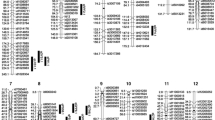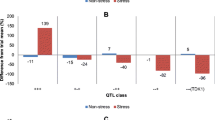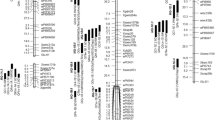Abstract
Drought accounts for significant yield losses in crops. Maize (Zea mays L.) is particularly sensitive to water stress at reproductive stages, and breeding to improve drought tolerance has been a challenge. By use of a linkage map with 121 single sequence repeat (SSR) markers, quantitative trait loci (QTLs) for grain yield and yield components were characterized in the population of the cross X178×B73 under water-stressed and well-watered conditions. Under the well-watered regime, 2, 4, 4, 1, 2, 2, and 3 QTLs were identified for grain yield, 100-kernel weight, kernel number per ear, cob weight per ear, kernel weight per ear, ear weight, and ear number per plant, respectively, whereas under the water-stressed conditions, 1, 5, 2, 6, 1, 3, and 2 QTLs, respectively, were found. The significant phenotypic correlations among yield and yield components to some extent were observed under both water conditions, and some overlaps between the corresponding QTLs were also found. QTLs for grain yield and kernel weight per ear under well-watered conditions and ear weight under both well-watered and water-stressed conditions over-lapped, and all were located on chromosome 1.03 near marker bnlg176. Two other noticeable QTL regions were on chromosome 9.05 and 9.07 near markers umc1657 and bnlg1525; the first corresponded to grain yield, kernel weight per ear, and ear weight under well-watered conditions and kernel number per ear under both water conditions, and the second to grain yield and cob weight per ear under water-stressed conditions and ear number per plant under both water conditions. A comparative analysis of the QTLs herein identified with those described in previous studies for yield and yield components in different maize populations revealed a number of QTLs in common. These QTLs have potential use in molecular marker-assisted selection.
Similar content being viewed by others
Abbreviations
- 100KW:
-
100-kernel weight
- ASI:
-
anthesis-silking interval
- CWE:
-
cob weight per ear
- ENP:
-
ear number per plant
- EW:
-
ear weight
- KNE:
-
kernel number per ear
- KWE:
-
kernel weight per ear
- QTL:
-
quantitative trait locus
- SSR:
-
single sequence repeat
- WS:
-
water-stressed
- WW:
-
well-watered
References
Agrama HAS and Moussa ME (1996) Mapping QTLs in breeding for drought tolerance in maize (Zea mays L.). Euphytica 91: 89–97.
Ajmone-Marsan P, Monfredini G, Brandolini A, Melchinger AE, Garay G, and Motto M (1996) Identification of QTL for grain yield in an elite hybrid of maize: repeatability of map position and effects in independent samples derived from the same population. Maydica 41:49–57.
Andrade FH, Vega C, Uhart S, Cirilo A, Cantarero M, and Valentinuz O (1999) Kernel number determination in maize. Crop Sci 39: 453–459.
Austin DF and Lee M (1996) Comparative mapping in F-2∶3 and F-6∶7 generations of quantitative trait loci for grain yield and yield components in maize. Theor Appl Genet 92: 817–826.
Austin DF and Lee M (1998) Detection of quantitative trait loci for grain yield and yield components in maize across generations in stress and non-stress environments. Crop Sci 38: 1296–1308.
Bruce WB, Edmeades GO, and Barker T (2002) Molecular and physiological approaches to maize improvement for drought tolerance. J Exp Bot 53: 13–25.
Edmeades GO, Bolaños J, Elings A, Ribaut JM, Bänziger M, and Westgate ME (1999) Selection improves drought tolerance in tropical maize populations. I. Grains in biomass, grain yield and harvest index. Crop Sci 39: 1306–1315.
Frova C, Krajewski P, Fonzo ND, Villa M, and Sari-Gorla M (1999) Genetic analysis of drought tolerance in maize by molecular markers. I. Yield components. Theor Appl Genet 99: 280–288.
Goldman IL, Rocheford TR, and Dudley JW (1993) Quantitative trait loci influencing protein and starch concentration in the Illinois long term selection maize strains. Theor Appl Genet 87: 217–224.
Goldman IL, Rocheford TR, and Dudley JW (1994) Molecular markers associated with maize kernel oil concentration in an Illinois high protein × Illinois low protein cross. Crop Sci 34: 908–915.
Hall AJ, Vilella F, Trapani N, and Chimenti C (1982) The effects of water stress and geno-type on dynamics of pollen-shedding and silking in maize. Field Crops Res 5: 349–363.
Hallauer AR and Miranda JB (1981) Quantitative Genetics in Maize Breeding. Iowa State University Press, Ames, Iowa.
Hoisington DA, Khairallah MM, and Gonzales-De-Leon D (1998) Laboratory Protocols: CIMMYT Applied Molecular Genetics Laboratory. CIMMYT, Mexico, DF, Mexico.
Lebreton C, Lazic-Jancic V, Steed A, Pekic S, and Quarrie SA (1995) Identification of QTL for drought responses in maize and their use in testing causal relationships between traits. J Exp Bot 46: 853–865.
Li XH, Gao GL, Liang XL, Yuan LX, Li MS, and Zhang SH (2002) Genetic diversity of drought tolerance at flowering time in elite maize germplasm. Acta Agron Sin 28: 595–600.
Maize Genetics and Genomics Database (2003) <http://www.maizegdb.org>.
Paterson A, Lander ES, Hewitt JD, Peterson S, Lincoln SE, and Tankley SD (1988) Resolution of quantitative traits into mendelian factors by using a complete linkage map of restriction fragment length polymorphisms. Nature 335: 721–726.
Ribaut JM, Jiang C, Gonzalez-de-Leon D, Edmeades GO, and Hoisington DA (1997) Identification of quantitative trait loci under drought conditions in tropical maize. II. Yield components and marker-assisted selection strategies. Theor Appl Genet 94: 887–896.
Ritchie SW, Nguyen HT, and Holaday AS (1990) Leaf water content and gas exchange parameters of two wheat genotypes differing in drought resistance. Crop Sci 30: 105–111.
Sanguineti MC, Tuberasa R, Landi P, Salvi S, Maccaferri M, Casarini E, and Conti S (1999) QTL analysis of drought-related traits and grain yield in relation to genetic variation for leaf abscisic acid concentration in field-grown maize. J Exp Bot 50: 1289–1297.
Schon CC, Melchinger AE, Boppenmaier J, Brunklaus-Jung E, Herrmann RG, and Seitzer JF (1994) RFLP mapping in maize—quantitative trait loci affecting testcross performance of elite European flint lines. Crop Sci 34: 378–389.
Schussler JR and Westgate ME (1995) Assimilate flux determines kernel set at low water potential in maize. Crop Sci 35: 1074–1080.
Tuberosa R, Salvi S, Sanguineti MC, Landi P, Maccaterri M, and Conti S (2002a) Mapping QTLs regulating morpho-physiological traits and yield: case studies, shortcomings and perspectives in drought-stressed maize. Ann Bot 89: 941–963.
Tuberosa R, Sanguineti MC, Landi P, Giuliani MM, Salvi S, and Conti S (2002b) Identification of QTLs for root characteristics in maize grown in hydroponics and analysis of their overlap with QTLs for grain yield in the field at two water regimes. Plant Mol Biol 48: 697–712.
Veldboom LR and Lee M (1996) Genetic mapping of quantitative trait loci in maize in stress and nonstress environments: É. Grain yield and yield components. Crop Sci 36: 1310–1319.
Wang SC, Basten CJ, and Zeng ZB (2003) WinqtlCart, version 2.0. Program in Statistical Genetics, North Carolina State University, Raleigh, North Carolina.
Westgate ME and Boyer JS (1985) Osmotic adjustment and the inhibition of leaf, root, stem, and silk growth at low water potentials in maize. Planta 164: 540–549.
Westgate ME and Grant DLT (1989) Water deficits and reproduction in maize. Plant Physiol 91: 862–867.
Zeng ZB (1994) Precision mapping of quantitative trait loci. Genetics 136: 1457–1468.
Author information
Authors and Affiliations
Corresponding authors
Rights and permissions
About this article
Cite this article
Xiao, Y.N., Li, X.H., George, M.L. et al. Quantitative trait locus analysis of drought tolerance and yield in Maize in China. Plant Mol Biol Rep 23, 155–165 (2005). https://doi.org/10.1007/BF02772706
Issue Date:
DOI: https://doi.org/10.1007/BF02772706




